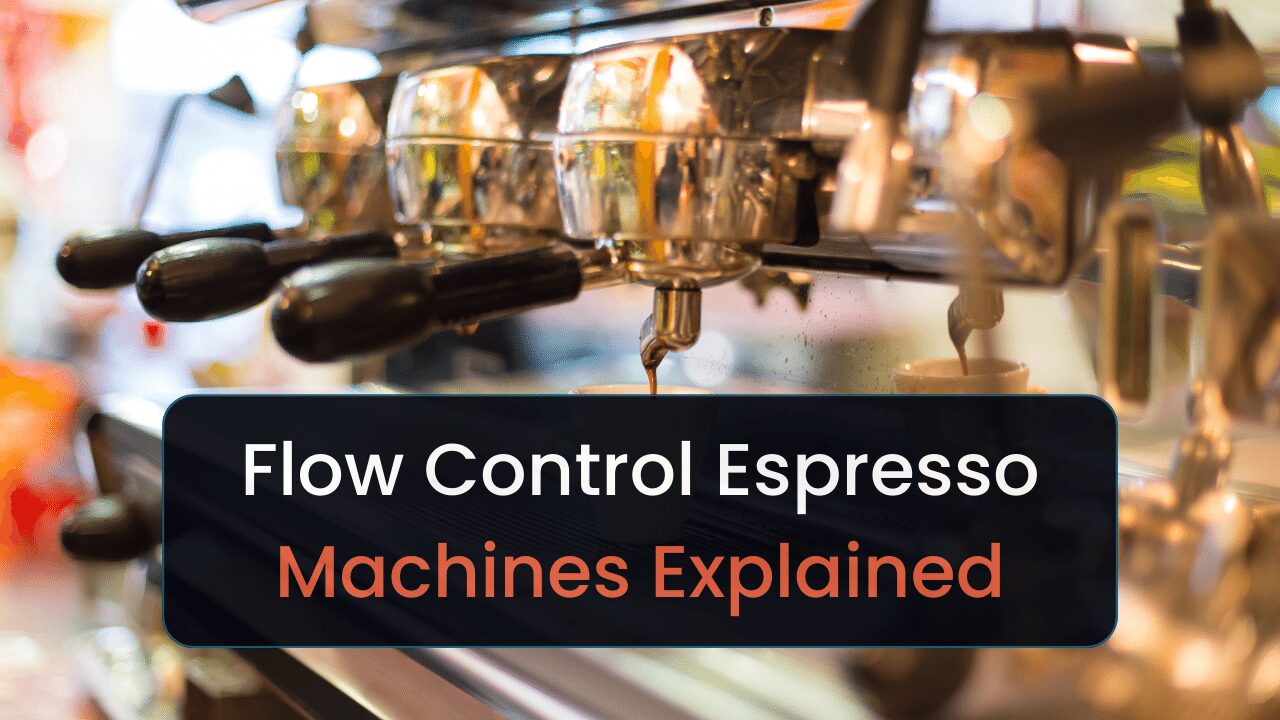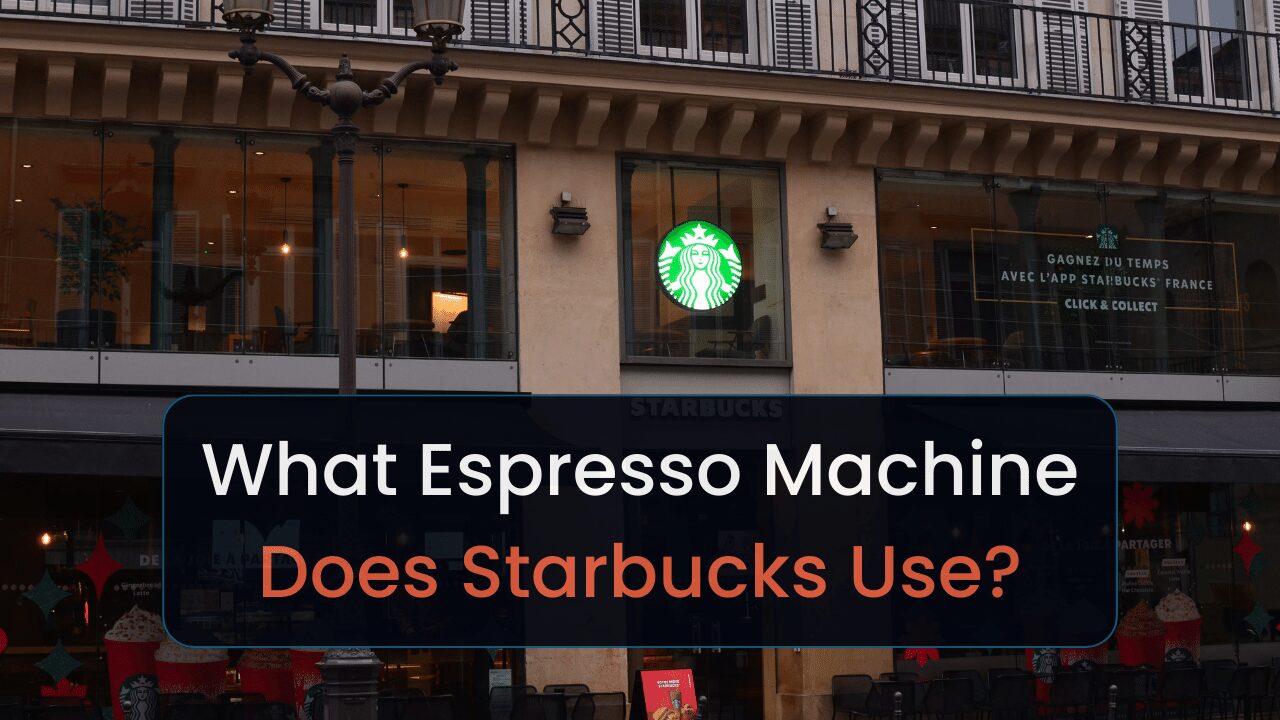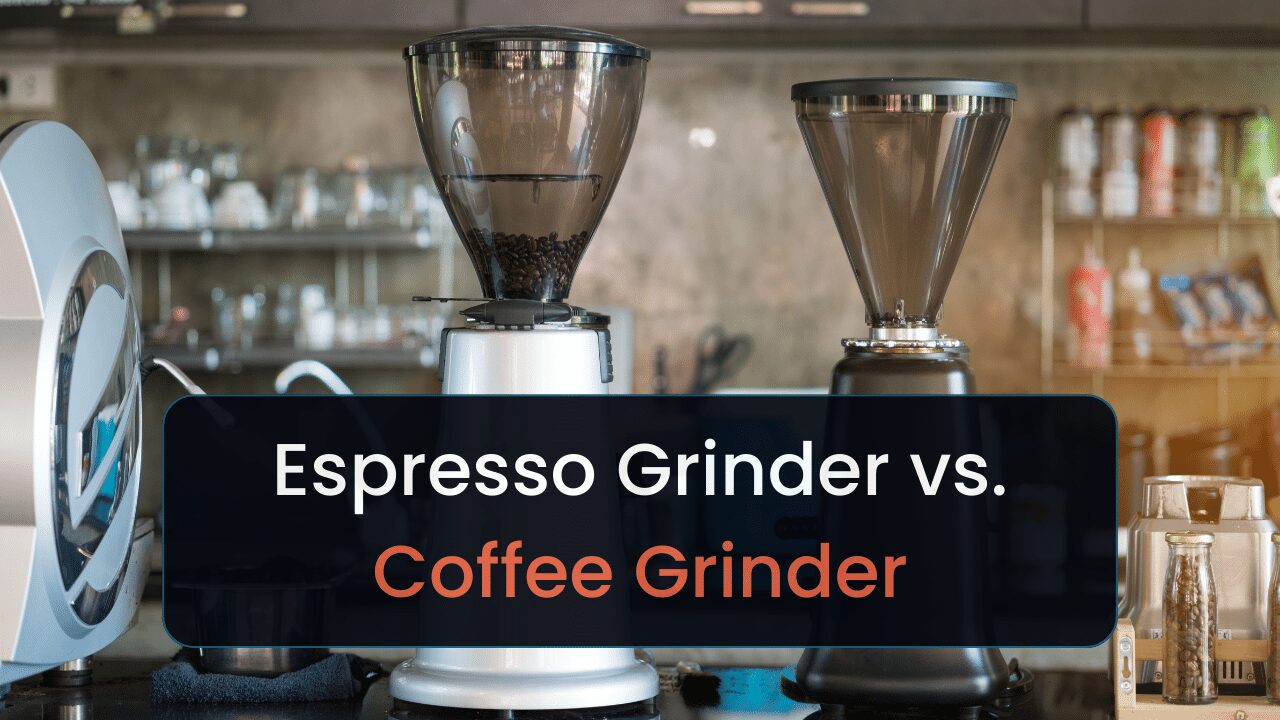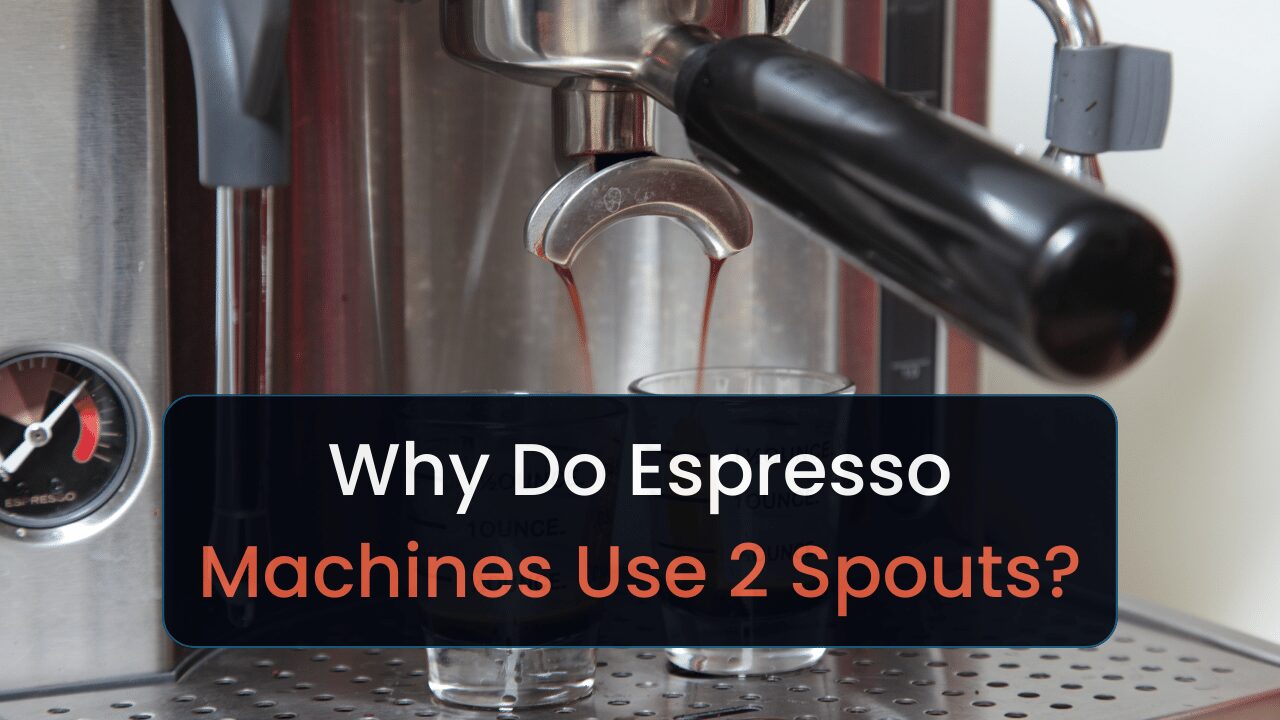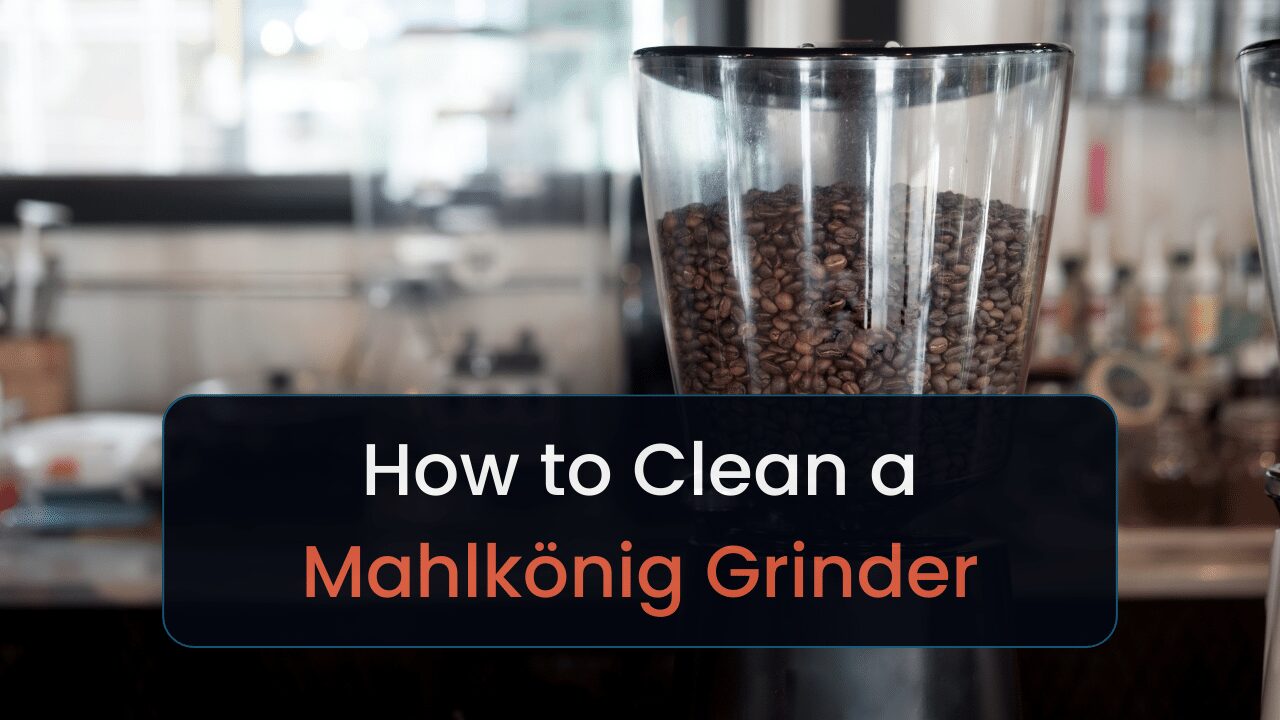Hi, I’m Tim, a coffee enthusiast. I brew fresh coffee and espresso daily and have a ton of experience with whole beans and ground coffee.
So, I made this guide to help explain their fundamental differences.
Let’s get started.
Key Takeaways
- Whole-bean coffee is more flavorful and has more aromas.
- With whole-bean coffee, you can grind it to different sizes whenever you make coffee. With pre-ground coffee, you’re locked into a single grind size.
- Ground coffee has more demand and a shorter shelf-life, so it tends to be less expensive.
- Ground coffee has less preparation and cleanup time.
Whole Beans and Ground Coffee Differences
Here are the main differences between whole-bean and ground coffee.
| Type | Whole Bean Coffee | Ground Coffee |
| Best For | All types of coffee drinks | Dependent on grind size |
| Grind Size | Any– you grind it the way you want it | Single grind size per package |
| Shelf Life | ~1 year | ~1-2 weeks after opening |
| Freshness | Best freshness | Fair freshness |
| Flavor | More flavorful | Less flavorful |
| Price | $$ | $ |
| Caffeine Content | Same | Same |
| Drink Type | Unlimited | Limited to brew coffee |
| Prep Time | Longer because you have to grind the beans | Shorter because you don’t need to grind the beans |
| Clean Up Time | Longer because you need to clean the coffee grinder | Shorter because you don’t need to clean a grinder |
Who Should Get What?
If you like grinding your own coffee and want the freshest cup of coffee or espresso possible, get whole beans. If you don’t have a lot of time and don’t care as much about freshness, buy ground coffee.
1. Grind Size
When it comes to the grind size of your coffee, whole beans offer more control and flexibility than ground coffee.
With whole beans, you can choose a coarser or finer grind, depending on your desired drink type.
A coarse grind is best for French press or cold brew, while a finer grind is ideal for espresso machines or pour-over coffee.
On the other hand, pre-ground coffee generally comes in one size and is not adjustable. So, you can’t decide you want French press one day and espresso the next, as these require different grind sizes.
2. Shelf Life/How long they last
Whole bean coffee has a longer shelf life than pre-ground coffee due to its lower surface area.
The less exposed surface area means that whole beans have fewer opportunities for oxidation and degradation, resulting in a fresher, more flavorful cup of coffee.
Unopened ground coffee lasts about 2-3 months before it starts to go stale. Unopened whole beans last about a year. Opened ground coffee and whole beans start to go stale after about a week or two.
3. Freshness
Whole-bean coffee is the obvious winner in terms of freshness. Since they are not ground until you are ready to brew, whole beans stay fresher longer and give off a stronger aroma.
On the other hand, ground coffee loses its flavor and aroma within hours of being ground, making it less desirable for those looking for a strong, fresh cup of coffee.
4. Flavor
Whole beans produce a more robust flavor than pre-ground coffee due to the aforementioned freshness factor.
Since you don’t grind them until you brew them, the beans retain more natural oils and flavors. Pre-ground coffee tends to taste flat and dull in comparison, as some of these oils have dissipated over time.
5. Price
When it comes to price, ground coffee tends to be cheaper than whole beans. Ground coffee is cheaper simply because there is more demand for it and is lower quality.
Depending on the quality of beans and type of grind, ground coffee can cost anywhere from $6-15 per pound, while whole bean coffee is usually closer to $10-20 per pound.
This means that you can save money for the same amount of coffee by going with pre-ground.
6. Caffeine Content
There is no significant difference between the amount of caffeine in whole bean and ground coffee. The amount of caffeine in coffee depends more on the roast and variety than the form it comes in.
While ground coffee will get stale faster, the caffeine content stays the same, as it is a very stable compound. [1]
7. Drink Type Limitations
Regarding the type of drinks you can make with whole bean and ground coffee, there are some notable differences.
With whole beans, you have unlimited options for types of coffee drinks you can make. From espresso to pour-over, French press, or cold brew, the grind size can be adjusted accordingly to create whatever drink you desire.
On the other hand, most pre-ground coffee is limited to brewing coffee in a traditional drip machine.
8. Preparation Time
Whole beans take more time to prepare than ground coffee due to the need to grind the beans.
This can add an extra 5-10 minutes of prep time, depending on the type of coffee grinder you use and how fine your desired grind size is.
9. Clean-Up Time
Additionally, you will also need to clean up after grinding the beans, which can be a bit of a chore. Most burr grinders require some disassembly and wiping down to remove coffee grounds.
On the other hand, pre-ground coffee requires no additional cleanup outside of the normal cleaning of your coffee machine.
Whole Bean Coffee Pros and Cons
Here are the pros and cons of whole-bean coffee.
Pros
Freshness
Whole bean coffee retains its freshness much longer than pre-ground coffee. The beans are protected by their outer shell, which prevents the flavor and aroma from escaping.
Grinding the beans just before brewing ensures you get the freshest possible cup of coffee.
Customization
When you grind your own beans, you have control over the grind size, which can affect the taste of your coffee.
You can adjust the grind to suit your brewing method, whether you prefer French press, pour-over, or espresso. You can also experiment with different roast levels and blends to find your perfect cup of coffee.
Flavor
Whole bean coffee has a more complex and nuanced flavor than pre-ground coffee.
The beans’ natural oils and flavors are preserved until you grind them, which can lead to a more flavorful and aromatic cup of coffee.
Health benefits
Coffee is known to have various health benefits, including improving cognitive function, reducing the risk of certain diseases, and boosting metabolism.
Whole bean coffee may have even more health benefits than pre-ground coffee, as the beans keep in more of their natural antioxidants and nutrients.
Environmentally friendly
Buying whole-bean coffee can be more environmentally friendly than buying pre-ground coffee. When you buy pre-ground coffee, it often comes in single-use packaging that can’t be recycled.
When you purchase whole-bean coffee, you can use a reusable coffee filter and compost the coffee grounds, reducing your waste.
Cost-effective
While whole-bean coffee may seem more expensive than pre-ground coffee, it can actually be more cost-effective in the long run.
Whole-bean coffee stays fresh longer, so you don’t have to buy it as often. Additionally, buying in bulk can save you money over time.
Aesthetics
Finally, there’s something to be said about the aesthetic appeal of whole-bean coffee. The beans themselves are beautiful, with a variety of colors and textures, and the act of grinding the beans can be a meditative and enjoyable experience.
Plus, the aroma of freshly ground coffee is hard to beat.
Cons
Requires a grinder
To brew whole-bean coffee, you need a coffee grinder. This means additional equipment to buy, maintain, and store. You need to have a grinder or remember to grind your coffee beans to be able to enjoy your coffee.
Inconsistent grind
Even with a high-quality grinder, it can be challenging to achieve a consistent grind. Inconsistent grind size can lead to uneven extraction, resulting in a weaker or bitter-tasting cup of coffee.
More expensive
Whole-bean coffee tends to be more costly than pre-ground coffee. This is because whole-bean coffee requires more processing and packaging to maintain its freshness. Additionally, the cost of a coffee grinder adds to the overall expense.
Time-consuming
Grinding coffee beans takes time, and it can be a hassle for those who are always on the go. If you’re in a rush, pre-ground coffee may be a more convenient option.
Messy
Grinding coffee beans can be a messy process, with coffee grounds spilling and scattering everywhere. This can be especially frustrating if you’re in a hurry or have limited space in your kitchen.
Requires storage
Storing whole-bean coffee correctly is crucial to various its freshness and flavor. This means storing it in an airtight container away from heat, light, and moisture.
If you don’t have space for storage or forget to store your coffee correctly, it can quickly lose its quality.
Ground Coffee Pros and Cons
Here are the pros and cons of ground coffee.
Pros
Convenience
Ground coffee is very convenient as it is pre-ground and ready to use. This saves time and effort, especially for those who are always on the go or have busy schedules.
Consistency
Ground coffee ensures consistency in flavor and strength as the grind size is consistent. This means the coffee taste will be the same every time it is brewed, providing a reliable coffee experience.
Lower cost
Ground coffee typically costs less than whole-bean coffee as it is cheaper to produce and package. Additionally, there is more demand for it, and has less quality than whole-bean coffee. This makes it an excellent option for those on a budget or looking for an affordable coffee option.
Easy to store
Ground coffee is easy to store as it can be stored in an airtight container in a cool, dry place. This ensures the coffee stays fresh and does not lose flavor or aroma.
Accessibility
Ground coffee is widely available in most grocery stores, making it easily accessible to most consumers. This means you can easily find and purchase your favorite coffee blend or flavor without searching for specialty coffee shops.
Cons
Shorter shelf life
Ground coffee has a limited shelf life due to its exposure to air and moisture, which can cause it to lose its flavor and aroma over time. It is best to use freshly ground coffee within a few days of grinding.
Risk of contamination
Ground coffee is more susceptible to contamination as it is exposed to the environment during the grinding process. This can lead to the growth of bacteria and mold, which can be harmful to health.
Loss of nutrients
Ground coffee can lose some nutrients during the grinding process, such as antioxidants and other beneficial compounds. This can reduce the health benefits of drinking coffee.
Environmental impact
The production and disposal of ground coffee can have a negative impact on the environment. The manufacturing process requires energy and resources, and the packaging can contribute to waste in landfills.
Limited brewing options
Ground coffee is limited in brewing options, as it is best suited for traditional drip coffee makers and French presses. Other brewing methods, such as espresso machines and pour-over methods, require specific grinds that may not be available in pre-ground coffee.
How to Make Whole-Bean Coffee
Making whole-bean coffee is a simple process that requires basic equipment and a few steps.
1. Pick the Right Beans
Start by selecting the type of coffee beans you want to use for your cup. Whole bean coffee is available in various roasts and flavors, so choose one that suits your tastes. Once you have chosen your beans, measure two tablespoons per six ounces of water.
2. Grind the Beans
Now that you have your beans and measurements, it is time to grind them. Whole-bean coffee does not come pre-ground, so you will need a reliable coffee grinder to do this.
Electric grinders are ideal for grinding large amounts of coffee quickly and evenly, but you can also use manual or blade grinders. Make sure to choose the best setting for your brewing method, as a finer grind will be needed for espresso and a coarser grind for French Press.
If you don’t have a coffee grinder, check out our coffee grinding guide for additional grinding methods.
3. Brew Your Coffee
Finally, it is time to brew! Place the ground coffee into your chosen brewing device and add the desired amount of hot water. Allow it to steep for 3-5 minutes, then strain or remove the grounds before pouring your cup of fresh whole-bean coffee.
Ground Coffee Vs. Instant Coffee
The main difference between ground coffee and instant coffee is how you prepare them.
Ground coffee is made from freshly roasted whole beans that range from a fine to coarse grind. With coffee grounds, you use a coffee maker, french press, pour-over, or other coffee brewing methods to make your drink.
Instant coffee is made from dried, pre-ground powder that you add directly to a cup of hot water. The instant coffee powder dissolves in the water, and your coffee beverage is ready to drink– no coffee machine is required.
Ground coffee has a richer flavor and aroma than instant coffee, as it uses fresh beans with more flavorful compounds.
It also requires more preparation time since the beans must be ground first. Instant coffee is faster to prepare but lacks the depth of flavor and aroma that ground coffee provides.
Whole Coffee Beans Vs. Ground Measurement
The correlation between whole-bean and ground coffee is about one-to-one. So, if you have 12 oz of whole beans, that equals about 12 oz of ground coffee.
That said, whole beans will take up more volume compared to the same weight of ground coffee. Whole beans will have dead space between the beans, whereas grounds will not.
FAQs
Here are some common questions about whole-bean and ground coffee.
Is it better to buy whole-bean coffee or ground?
It is generally better to purchase whole-bean coffee as it tastes fresher and has more flavor.
Ground coffee can be easier to prepare but does not retain the same flavor and nutrients as whole-bean coffee. However, if you don’t have a coffee grinder, it is better to buy ground coffee.
Why do people prefer whole-bean coffee?
Many people prefer whole-bean coffee because it is fresher and has more flavor. Also, grinding the beans yourself allows for more control over the size of the grind, making it easier to use various brewing methods.
Why are whole beans better than ground?
Whole bean coffee retains more antioxidants and essential oils, making it more flavorful.
Compared to ground coffee, whole beans retain their flavor longer, making it a better option for those looking to enjoy the freshest cup of coffee possible.
What lasts longer, whole bean or ground coffee?
Whole-bean coffee typically lasts longer than ground coffee. This is because the whole beans are protected from air and moisture, which can cause them to go stale more quickly.
Whole bean coffee, when kept in an airtight container in a cool and dry place, can last up to 12 months. You should use ground coffee within two weeks of grinding for optimal flavor and aroma.
Final Thoughts
When it comes to whole bean vs. ground coffee, both have their advantages and disadvantages.
Whole beans retain more flavor and nutrients but take longer to prepare. Ground coffee is faster to make but has less flavor and aroma.
When deciding which to buy, consider the amount of time you have for preparation and how important flavor and aroma are for you.
Looking for the best grind size for the coffee beverage you want to brew? Check out our guide on coffee grind sizes for more information.

